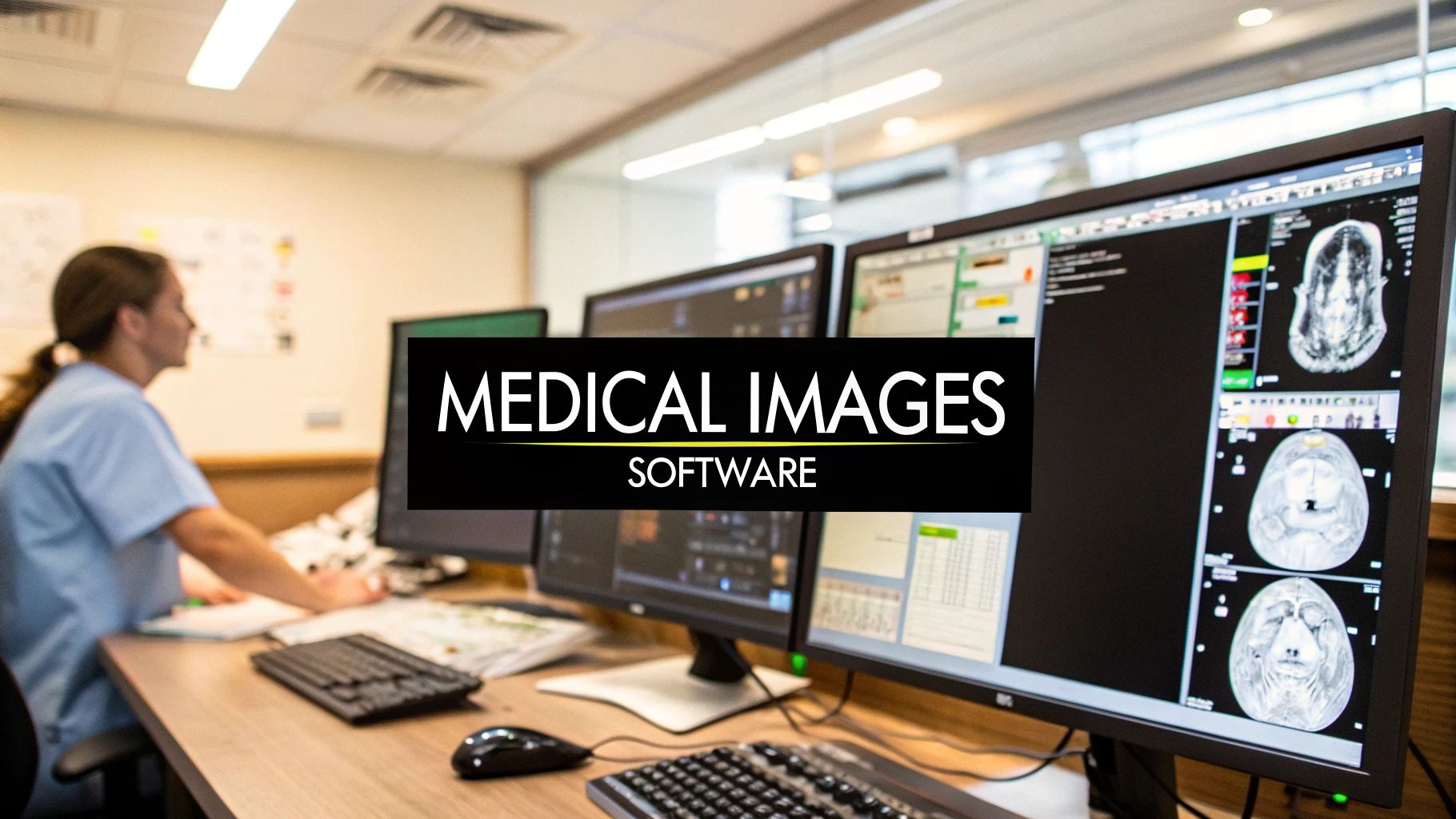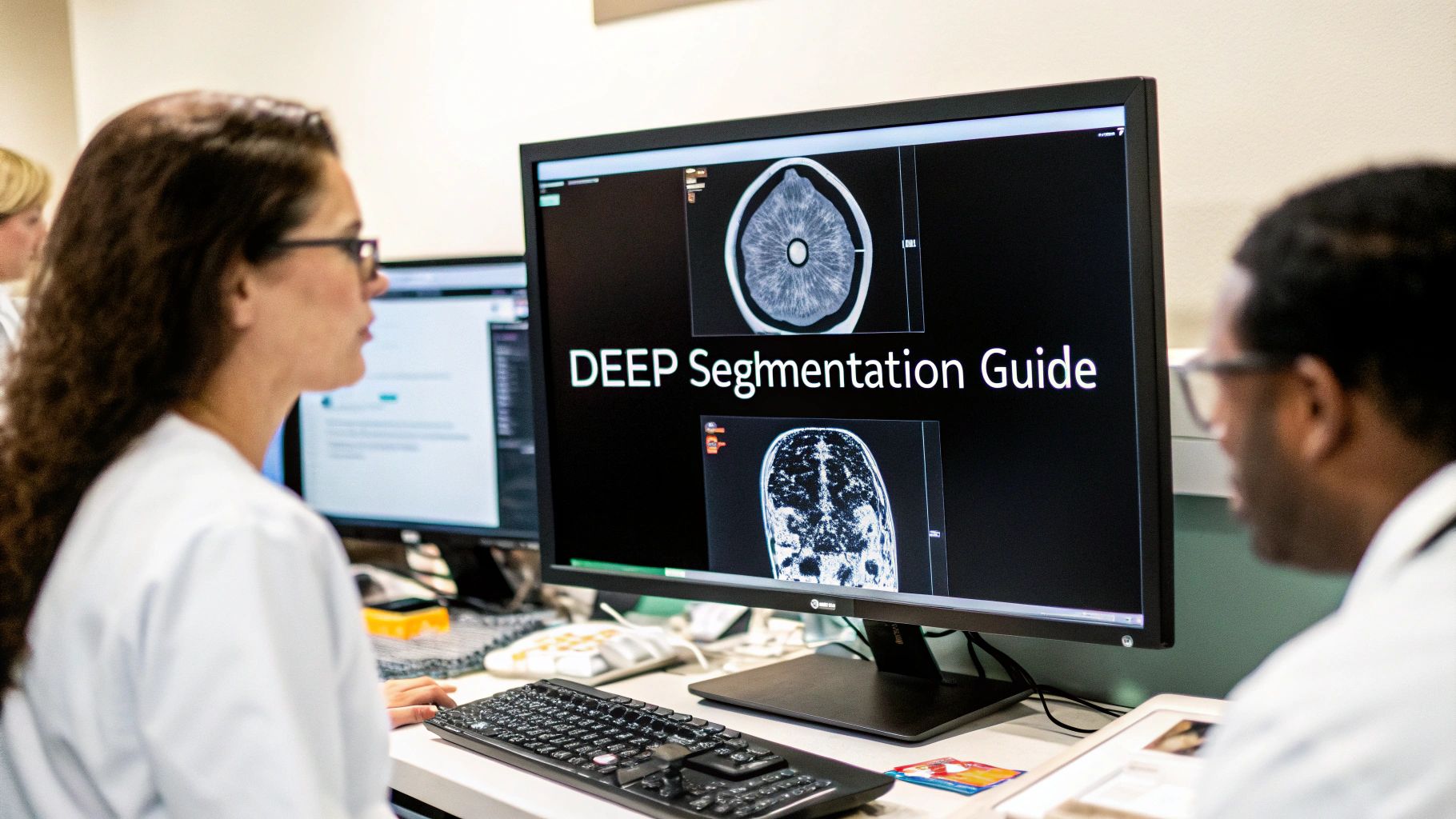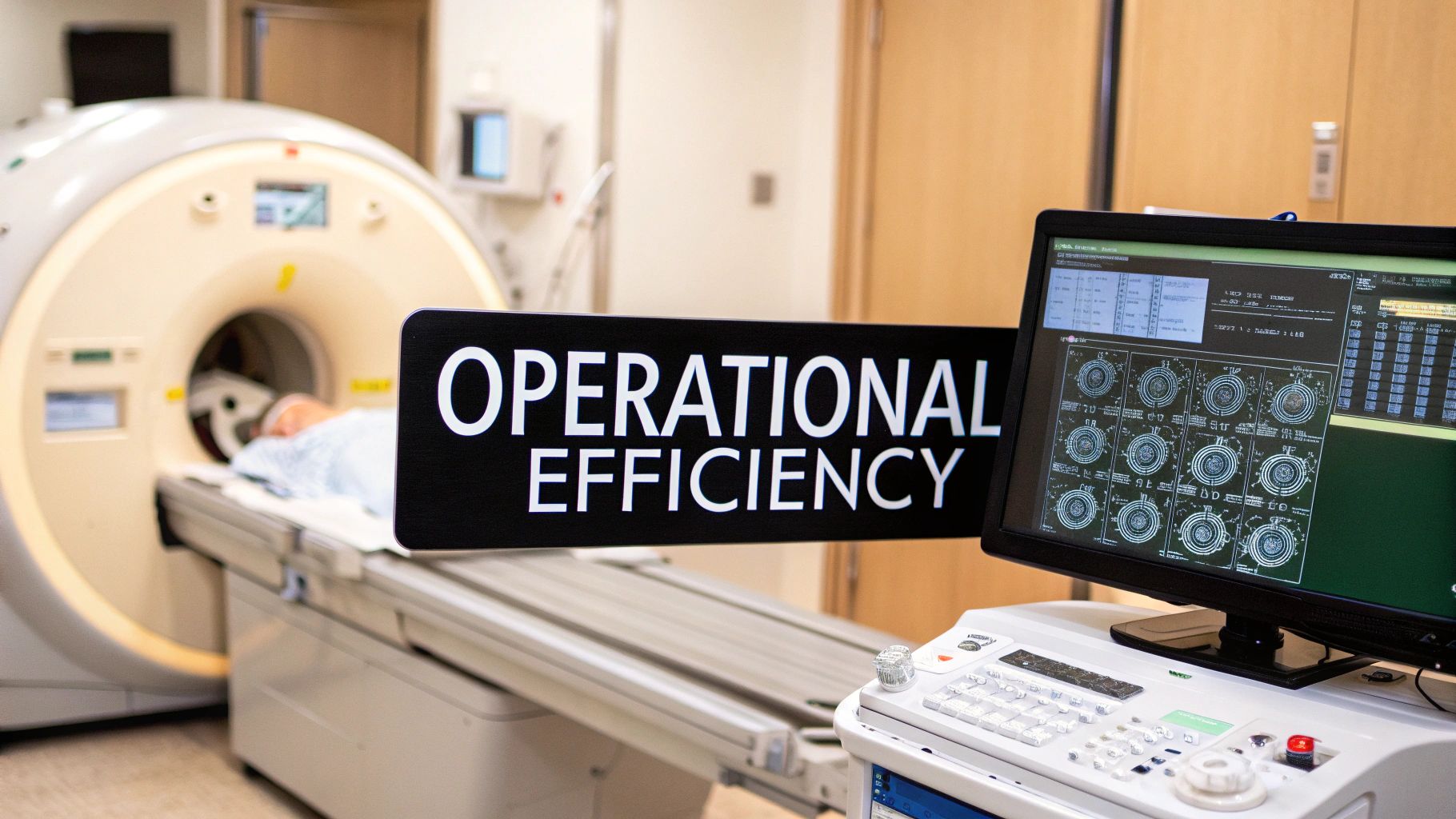Unlocking the Power of Google Healthcare API

The Google Healthcare API is changing how healthcare data is managed and used. It bridges the gap between separate systems, unlocking valuable insights from the considerable amount of data the healthcare industry generates daily. This gives healthcare providers a more complete picture of patient health, leading to more informed clinical decisions and improved patient outcomes.
Bridging the Gaps in Healthcare Data
One of the Google Healthcare API's key strengths is its ability to unify different healthcare data standards. It supports FHIR, HL7v2, and DICOM, allowing seamless integration between systems that previously struggled to communicate. This interoperability is crucial for improving care coordination, streamlining workflows, and fostering collaboration among healthcare providers.
Real-World Applications and Impact
The Google Healthcare API isn't just theoretical; organizations are actively using it to achieve tangible results. For example, the Los Angeles Network of Enhanced Services (LANES), a prominent health information organization, adopted the Google Cloud Healthcare API in July 2023. LANES supports 10 million lives and manages over half a billion transactions annually, showcasing the API's ability to handle large-scale data operations. This implementation has improved access to critical patient information for providers across the greater Los Angeles area. Learn more about LANES and their work with the API here.
Empowering Innovation in Healthcare
Beyond data integration, the Google Healthcare API empowers developers to create innovative healthcare applications. By providing a secure and robust platform for data exchange and analysis, the API allows developers to focus on building solutions instead of dealing with technical complexities. This fosters the development of applications in areas like AI-powered diagnostics, personalized medicine, and remote patient monitoring.
Integrating with Google Cloud's Powerhouse Tools
The true power of the Google Healthcare API is enhanced by its integration with other Google Cloud services. This includes powerful tools like BigQuery for large-scale data warehousing and analytics, and Vertex AI for developing and deploying machine learning models. This integration allows healthcare organizations to extract deeper insights from their data and develop more sophisticated solutions. These combined capabilities allow organizations to leverage the full potential of their data, leading to a more efficient and innovative healthcare ecosystem. This also enables robust data analysis and the development of predictive models, further enhancing the value and usability of the Google Healthcare API.
Google Healthcare API Market Dynamics and Opportunities
The healthcare API market is rapidly changing. This evolution is fueled by the increasing need to connect different healthcare systems and the growing popularity of digital health solutions. This move towards integrated healthcare creates exciting opportunities for both healthcare providers and software developers. Google, with its powerful Google Healthcare API, is poised to be a major player in this shift.
Market Drivers and Growth Projections
Several factors are driving the increased use of healthcare APIs. Government regulations, such as the 21st Century Cures Act, mandate increased patient access to their electronic health information. This, in turn, demands secure and efficient ways to share this data.
The need for smooth data flow between different healthcare systems is also growing. This interoperability is essential for better care coordination and provides a more complete picture of a patient's health. This growing demand also reflects the trend towards patient empowerment and personalized medicine.
The global healthcare API market was valued at about USD 1.25 billion in 2024. Projections show a growth rate of roughly 5.4% between 2025 and 2030. This growth is partly thanks to regulatory changes, such as the 21st Century Cures Act, which requires readily available electronic health information for patients. Find more detailed statistics here. Google Cloud, with its scalable and secure API infrastructure, plays a crucial role in this growth.
To illustrate Google's position within the growing healthcare API market, let's examine some regional projections. The following table provides a snapshot of market size, projected growth, and key drivers across different regions, as well as a general estimate of Google's current market share.
Healthcare API Market Growth Projections
| Region | Market Size (2024) | Projected Growth | Key Drivers | Google's Market Share |
|---|---|---|---|---|
| North America | $500 million | 6% | High adoption of digital health solutions, strong regulatory framework | 30% |
| Europe | $350 million | 5% | Growing focus on data privacy and security, increasing government initiatives | 25% |
| Asia Pacific | $250 million | 7% | Expanding healthcare infrastructure, rising demand for telehealth services | 20% |
| Rest of the World | $150 million | 4% | Increasing awareness of healthcare APIs, growing investment in healthcare IT | 15% |
As you can see, North America currently holds the largest market share, driven by high adoption rates of digital health solutions and a well-established regulatory environment. However, the Asia Pacific region shows the highest projected growth, fueled by expanding healthcare infrastructure and increasing demand for telehealth services. While market share data is still evolving, Google's presence is significant across all regions, underpinning its importance in the global healthcare API landscape.
Google's Strategic Positioning and Competitive Advantages
Google's Healthcare API has several key advantages in this evolving marketplace. It supports important healthcare data standards, including FHIR, HL7v2, and DICOM. This allows for easy integration with current healthcare systems.
The API’s robust security measures, designed with HIPAA compliance in mind, address important concerns about patient data privacy. These factors contribute to Google’s strong position in this growing market.
Emerging Adoption Patterns and Industry ROI
The Google Healthcare API is being adopted across diverse healthcare settings. Hospitals, research institutions, and health tech startups are using the API to streamline workflows, boost research capabilities, and create new solutions. Early adopters are already seeing significant returns on their investment. These returns come through improved operational efficiency, better data insights, and faster innovation.
For instance, some hospitals are using the API to improve data sharing between departments. This results in faster diagnoses and more coordinated care, which also leads to better resource allocation and cost savings.
Aligning with Healthcare's Future: Google's Development Roadmap
Google is continuing to invest in the growth of its Healthcare API. The company is focused on integrating new technologies, such as AI and machine learning, to further support healthcare organizations. This future-focused strategy helps ensure that the Google Healthcare API stays at the forefront of innovation, meeting the changing needs of the healthcare industry.
This ongoing development reinforces Google’s dedication to supporting the development of personalized medicine and preventative care. As the healthcare industry increasingly relies on data-driven solutions, the Google Healthcare API will play a vital role in shaping the future of healthcare.
Real-World Implementation of Google Healthcare API

This section explores the practical side of deploying the Google Healthcare API. We'll examine how organizations are successfully using this technology and the positive outcomes they're seeing. This guide offers practical advice for every step of your implementation.
Preparing Your Infrastructure and Team
A successful implementation needs a strong foundation. This means preparing your current infrastructure and ensuring your team has the right skills. Think of it like constructing a building: a solid foundation and skilled workers are essential for a stable structure.
Assess your current systems for compatibility problems. Plan your data migration strategy, which might involve mapping data fields between your systems and the Google Healthcare API. Building a team proficient in healthcare data and the API is also vital.
Integrating with Existing EHRs and Legacy Systems
Many healthcare organizations already use Electronic Health Record (EHR) systems and other legacy infrastructure. Integrating the Google Healthcare API with these systems can be challenging. A well-defined approach, however, can minimize disruptions.
A phased rollout is a common strategy. This allows for testing and refinement at each step. A hospital, for example, might integrate the API with its radiology department first, then expand to other areas. This minimizes risk and allows for adjustments. Proven methods for data mapping, authentication, and ETL (Extract, Transform, Load) processes can also streamline the integration.
Navigating Technical Hurdles and Ensuring Data Integrity
Technical challenges are unavoidable with any API implementation. Anticipating these hurdles can simplify the process. Common challenges include data formatting inconsistencies and authentication issues.
Overcoming these requires careful planning and understanding the Google Healthcare API's features. Consistent data formatting across different systems is crucial for accurate analysis. Thorough testing and validation procedures are essential for maintaining data integrity.
Case Studies: Real-World Examples of Successful Implementation
Learning from other organizations offers valuable insights. This section examines case studies of successful Google Healthcare API implementations. These examples highlight best practices and the API’s tangible benefits.
For instance, we'll explore how organizations are using the API to improve data interoperability and support patients. These real-world examples provide practical guidance and inspiration.
Budgeting and Timeline Expectations
Realistic budgeting and timelines are crucial. The cost will depend on factors like your organization's size and the complexity of the integration.
Create a detailed budget that covers all implementation costs, including infrastructure, training, and maintenance. A realistic timeline with clear milestones helps keep the project on track. A phased approach can effectively manage costs and timelines, beginning with a pilot project before full-scale implementation.
Measuring Success: Key Benchmarks and Metrics
How do you measure success? Defining clear metrics is key. These might include improved clinician data access, reduced processing time, or better patient engagement.
Tracking these metrics demonstrates the Google Healthcare API's value and enables data-driven adjustments. For example, if you're improving data access, track the time it takes clinicians to retrieve patient information. This quantifies the API's impact and identifies areas for optimization. Regularly evaluating these benchmarks ensures the implementation delivers the expected results and maximizes its long-term value.
Hospital Success Stories With Google Healthcare API

The Google Healthcare API offers significant potential for hospitals. However, realizing this potential hinges on meticulous planning and execution. What distinguishes successful projects from those that falter? This section explores the key factors contributing to positive outcomes in hospital settings, based on insights from healthcare IT leaders and real-world case studies. We'll examine how leading hospitals use the Google Healthcare API to enhance clinical workflows, improve care coordination, and boost operational efficiency.
Enhancing Clinical Workflows
Forward-thinking hospitals are using the Google Healthcare API to optimize clinical processes. For instance, some have integrated the API with their Electronic Health Record (EHR) systems to enhance data accessibility for clinicians. This translates to faster access to patient information, empowering clinicians to make more informed decisions and reach quicker diagnoses.
The Google Healthcare API also facilitates seamless data exchange between different departments, such as radiology and pathology. This enhanced interdepartmental communication leads to more efficient workflows and a more coordinated, effective approach to patient care.
Improving Care Coordination
The Google Healthcare API plays a crucial role in improving care coordination. By enabling secure and efficient data sharing between various healthcare providers, the API promotes a more collaborative approach to patient care. This allows specialists to readily access patient records, regardless of where the patient received prior care.
This streamlined access to information promotes more informed treatment plans and mitigates the risk of medical errors, resulting in a more coordinated and comprehensive patient care experience.
Driving Operational Efficiencies
Beyond clinical improvements, the Google Healthcare API presents substantial opportunities for enhancing operational efficiency. Hospitals are using the API to automate tasks, reduce administrative burdens, and optimize resource allocation.
This automation frees up valuable staff time, allowing them to prioritize patient care over administrative duties. This focus on core responsibilities can enhance patient satisfaction and lead to better overall outcomes. The adoption of healthcare APIs has witnessed significant growth, particularly in the US. Around 33.3% of hospitals enable patients to access their electronic health data via APIs. Learn more about this trend. This growth is further fueled by the rise of advanced EHR systems, with vendors like Epic leading the charge, where close to 60% of their users have enabled patient data access through APIs.
Measuring ROI and Securing Clinician Buy-In
Measuring return on investment (ROI) is crucial for any technology implementation. Innovative hospitals are tracking key metrics, such as reduced readmission rates, improved diagnostic accuracy, and increased patient satisfaction, to demonstrate the value proposition of the Google Healthcare API. This data-driven approach justifies continued investment and showcases the API's tangible benefits.
Securing clinician buy-in is equally vital. Successful implementations involve clinicians from the outset, incorporating their feedback into the design and implementation process. This collaborative approach ensures the solution aligns with their needs and workflows, improving the likelihood of adoption and long-term success.
Scaling Implementations for Enterprise-Wide Impact
Leading hospitals are strategically scaling their implementations of the Google Healthcare API to achieve organization-wide impact. They typically commence with pilot projects in specific departments, refining their approach before expanding to other areas.
This phased rollout minimizes disruptions and allows for adjustments based on practical experience, ultimately ensuring that the benefits of the API are realized across the entire organization. This maximizes its potential to elevate patient care and drive operational improvements.
Google Healthcare API Across Global Markets
The Google Healthcare API is making a global impact on healthcare. However, its adoption isn't uniform. This article explores the varied landscape of the Google Healthcare API, including regional adoption trends, regulatory factors, and organizational strategies for navigating diverse healthcare environments.
Regional Variations in Adoption and Implementation
Adoption of the Google Healthcare API varies globally. Factors influencing uptake include existing healthcare infrastructure, technological advancement, and cultural views on health data sharing. Regions with advanced healthcare systems and a focus on digital health, such as North America and parts of Europe, demonstrate faster adoption. Cultural nuances also play a role, as societies with greater trust in digital technologies and data sharing are more likely to embrace solutions like the Google Healthcare API.
Regions with developing healthcare infrastructures often face challenges in adopting new technologies. This can be due to limitations in resources, both financial and technological, as well as a need for more comprehensive training and support for implementation. Addressing these challenges is key to expanding the reach and benefits of the API globally.
Navigating Regulatory Landscapes and Data Privacy
Data privacy regulations significantly shape the adoption of the Google Healthcare API. The European Union's General Data Protection Regulation (GDPR) sets high standards for processing personal data, including health information. This demands careful consideration of data security and privacy when implementing the API in European markets. Organizations operating in the EU must adhere to GDPR guidelines to maintain patient trust and avoid penalties. Similar regulations exist globally, creating a complex web of legal requirements for successful implementation.
The diversity of data privacy regulations globally necessitates a flexible approach to implementation. Organizations must be prepared to adapt their strategies to comply with specific regional requirements while upholding ethical data handling practices.
Adapting to Regional Requirements While Maintaining Global Best Practices
Organizations are adapting the Google Healthcare API to meet regional needs while adhering to global best practices. This requires understanding local regulations and the API's technical capabilities. Some organizations use data localization strategies, storing patient data within specific geographic boundaries to comply with data sovereignty laws. Others develop custom solutions for regional challenges, such as language barriers or limited internet access. This adaptive approach allows the API's benefits to be realized across diverse settings.
Balancing regional adaptation with global best practices is crucial for maximizing the API's impact. This approach ensures that the technology is used responsibly and effectively while respecting diverse healthcare systems and cultural contexts.
Strategic Considerations for Multinational Healthcare Entities
Multinational healthcare organizations face greater complexity implementing the Google Healthcare API. They must navigate varying regulations and cultural norms across countries while maintaining consistent data management and interoperability. This necessitates a robust global strategy that considers regional differences while adhering to core data security, privacy, and interoperability principles. This might include establishing regional data centers, implementing standardized data governance policies, and investing in training programs on local regulations and best practices.
Developing a comprehensive global strategy is essential for multinational organizations seeking to harness the power of the API. This strategy should address data governance, regulatory compliance, and practical considerations for operating across different healthcare systems.
Localization Insights for Maximum Effectiveness
Effective API implementation often relies on localization. This extends beyond translation and involves adapting the API's functionality and user experience to local cultural norms, clinical practices, and healthcare systems. Tailoring data input methods to match local provider preferences can enhance usability and adoption. Understanding local clinical workflows and integrating the API seamlessly into those processes can maximize its effectiveness and impact on patient care. By embracing localization, organizations can unlock the API's potential in global markets.
Localization is a key factor in realizing the full potential of the Google Healthcare API. By adapting the API to local contexts, organizations can ensure its relevance and usability, ultimately contributing to improved healthcare outcomes.
In North America, the dominance of the API stems from advanced healthcare infrastructure and favorable policies. The U.S. healthcare API market, valued at USD 60.69 million in 2024, is projected to reach USD 92.03 million by 2034. This growth is fueled by the rise of digital health tools like telemedicine and remote patient monitoring. Google’s Healthcare API plays a vital role in this expansion. Learn more here.
Securing Patient Data with Google Healthcare API
In healthcare, data security is paramount. The Google Healthcare API recognizes this and provides a robust framework for protecting sensitive patient information. This section explores the security measures incorporated into the API, examining how it safeguards data while enabling valuable functionality. We'll also see how these features help organizations maintain compliance with regulations like HIPAA and build trust with patients.
Encryption In Transit and At Rest
The Google Healthcare API uses strong encryption protocols to protect data both during transmission and storage. Data in transit is encrypted using HTTPS, ensuring secure communication between systems. Data at rest is encrypted using industry-standard encryption methods.
This multi-layered approach protects against unauthorized access, regardless of whether data is being exchanged or stored within Google's infrastructure. This provides a strong foundation for maintaining data confidentiality and integrity.
Access Controls and Authentication
Controlling access to sensitive patient data is crucial. The Google Healthcare API employs granular access controls to manage who can access what data. This involves authentication using industry-standard protocols, ensuring only authorized individuals and systems can interact with the information.
Role-based access control (RBAC) further refines these permissions. Administrators can define specific roles and assign corresponding data access privileges. This ensures individuals only access the information necessary for their tasks, minimizing the risk of unauthorized data exposure.
Audit Logging and Monitoring
A detailed audit trail is essential for security and compliance. The Google Healthcare API offers comprehensive audit logging, recording all data access and modification attempts. This allows administrators to monitor activity and quickly identify potential security breaches.
These logs can also be used to generate reports for regulatory purposes. This transparency and accountability reinforce the API's commitment to data security and regulatory compliance.
HIPAA Compliance and Data Protection
The Google Healthcare API is designed with HIPAA compliance in mind. Its security measures address the critical requirements of this regulation, protecting the privacy and security of protected health information (PHI). This includes provisions for data encryption, access controls, and audit logging.
This allows healthcare organizations to leverage the API's capabilities while adhering to stringent regulatory requirements. This focus on compliance provides a secure and reliable platform for handling sensitive patient data.
Practical Approaches to Risk Management
Healthcare security professionals use practical strategies to maximize data protection with the Google Healthcare API. This includes regular risk assessments to identify vulnerabilities and implement appropriate security measures. Vulnerability management processes ensure identified weaknesses are addressed promptly.
Incident response plans outline procedures for handling security incidents, enabling swift action to mitigate potential harm. These proactive measures contribute to a comprehensive security strategy, reducing the likelihood and impact of security events.
Security Documentation and Regulatory Reporting
Proper documentation simplifies compliance and strengthens accountability. Organizations using the Google Healthcare API maintain detailed security documentation outlining their security policies, procedures, and risk assessments.
This documentation streamlines regulatory reporting and demonstrates a commitment to responsible data handling. This transparency builds trust with patients and partners, reinforcing the organization's commitment to data security.
By incorporating these robust security measures, the Google Healthcare API empowers healthcare organizations to utilize valuable data insights while maintaining the highest standards of patient data protection. This balance of functionality and security makes it a valuable tool for responsible healthcare innovation.
The Future of Google Healthcare API Innovation
The Google Healthcare API is a dynamic tool, constantly adapting to the evolving healthcare landscape. This continuous improvement ensures its relevance and effectiveness in promoting innovation and enhancing patient care. Let's explore the exciting advancements on the horizon for the Google Healthcare API and how these developments will reshape healthcare interoperability.
AI Integration and Predictive Analytics
Google is actively integrating AI and machine learning into the Google Healthcare API. This empowers developers to build sophisticated healthcare applications. Imagine AI algorithms analyzing patient data to predict potential health risks before they escalate, leading to earlier interventions and better outcomes. AI-powered diagnostic tools can also improve the accuracy and speed of diagnoses, further elevating the quality of care. For more on managing healthcare documentation, check out these document management best practices.
Advanced Automation and Streamlined Workflows
The future of the Google Healthcare API includes advanced automation capabilities. These features will streamline healthcare workflows, freeing up valuable time for healthcare professionals to focus on patient care. Automating administrative tasks like data entry and report generation reduces the burden on staff, minimizes errors, and ultimately leads to cost savings and improved operational efficiency.
Evolving Standards: FHIR R5 and Beyond
The healthcare data landscape is constantly evolving. The Google Healthcare API embraces these changes, including supporting the latest FHIR R5 standard. This commitment ensures the API remains a relevant and powerful tool for data exchange. Supporting current standards enables seamless integration of new technologies and data sources, fostering innovation and improving patient care.
Pioneering Organizations and Beta Features
Forward-thinking organizations are exploring and implementing beta features of the Google Healthcare API. Early adoption provides a competitive edge, allowing for the development of innovative solutions and optimized workflows ahead of the curve. Some organizations are using beta features to explore AI-powered diagnostics and personalized medicine, pushing the boundaries of healthcare technology.
Practical Advice for Future-Proofing Your Organization
How can your organization prepare? Staying informed about upcoming Google Healthcare API enhancements and engaging with the developer community is crucial. This enables strategic planning and adaptation to the changing healthcare landscape. Investing in team training and development will equip them to leverage the API's full potential. A culture of continuous learning and adaptation keeps your organization at the forefront of healthcare innovation.
To illustrate the current capabilities and future potential of the Google Healthcare API, let's examine how it compares to other leading healthcare API solutions.
The following table, "Google Healthcare API Feature Comparison," provides a comparative analysis across key features, highlighting strengths and differences.
| Feature | Google Healthcare API | Azure API for FHIR | AWS HealthLake | IBM Watson Health |
|---|---|---|---|---|
| FHIR Standard Support | R4, R5 | R4 | R4 | R4 |
| Data Storage | Cloud Storage | Azure Blob Storage | S3 | Cloud Object Storage |
| Analytics & AI Integration | Native integration with Google Cloud AI Platform | Integration with Azure Machine Learning | Integration with Amazon SageMaker | Integration with Watson Studio |
| Security & Compliance | HIPAA, GDPR | HIPAA, GDPR | HIPAA, GDPR | HIPAA, GDPR |
| Scalability | Highly scalable | Highly scalable | Highly scalable | Highly scalable |
| Pricing | Pay-as-you-go | Pay-as-you-go | Pay-as-you-go | Varies by service |
As shown in the table, while all platforms offer robust features and adhere to important security and compliance standards, the Google Healthcare API stands out with its native integration with Google's AI and machine learning platform. This tight integration positions the API as a particularly strong choice for organizations looking to develop AI-powered healthcare solutions.
Ready to explore AI in medical imaging? PYCAD offers expertise in data handling, model training, and deployment for medical imaging solutions. Learn how PYCAD can transform your medical devices and improve patient outcomes.






